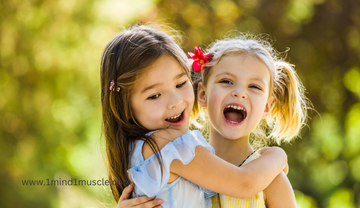Introduction
In today’s fast-paced world, maintaining children’s wellness has become more important than ever. With the rise of screen time, unhealthy eating habits, and lack of physical activity, it’s essential to focus on fostering overall health and well-being for children. Children’s wellness is about physical health and emotional and mental well-being, which are key to their development. In this article, we’ll explore various aspects of children’s wellness and provide practical tips to help ensure your child grows up in a healthy and balanced environment.
What is Children’s Wellness?
Children's wellness is a multifaceted concept that encompasses physical health, emotional well-being, mental development, and social growth. It is about creating a foundation for lifelong health habits, which help kids become resilient, confident, and well-rounded individuals. Ensuring children's wellness requires an integrated approach, where diet, exercise, mental health, and a positive environment work together to form a nurturing space for them to thrive.

Physical Health: The Foundation of Children's Wellness
A healthy body is essential for children's wellness, and physical activity plays a significant role in this. Exercise is not only beneficial for growing muscles and bones but also helps boost the immune system, improve cardiovascular health, and increase overall energy levels.
Encouraging Physical Activity
It's vital to get kids moving, whether through organized sports, outdoor play, or even simple activities like walking, dancing, or riding bikes. According to the World Health Organization, children should aim for at least 60 minutes of moderate to vigorous physical activity daily. Physical activity also promotes better sleep, reduces stress, and improves mood, all contributing to children’s wellness.
Healthy Eating Habits
In addition to physical activity, a balanced diet is a core component of children's wellness. Children need a variety of nutrients to support their growth, such as proteins, carbohydrates, fats, vitamins, and minerals. A diet rich in fruits, vegetables, whole grains, lean proteins, and healthy fats can help children build strong immune systems, enhance brain development, and maintain a healthy weight.
Encourage healthy eating habits by making nutritious foods fun and accessible. Getting kids involved in meal planning and preparation can foster an appreciation for healthy foods and create a sense of ownership over their diet.

Mental Health: Supporting Emotional Well-being
The emotional and mental wellness of children is just as important as their physical health. Mental health problems can manifest in a variety of ways, including anxiety, depression, or behavioral issues. Addressing emotional health early can prevent long-term struggles and help children develop strong coping mechanisms.
Open Communication and Emotional Expression
Creating an open environment where children feel safe expressing their emotions is crucial for fostering mental well-being. Encourage kids to talk about their feelings and listen actively when they do. When children understand that expressing their emotions is okay, it helps build emotional intelligence and resilience, both of which are vital for their overall wellness.
Promoting Positive Self-Image
A child’s self-esteem is deeply connected to their mental health. Encourage positive self-talk and praise children for their efforts rather than just outcomes. Helping them focus on progress rather than perfection fosters a growth mindset, leading to higher self-confidence.
Managing Stress and Anxiety
Children can experience stress, especially with school pressures or social challenges. Teaching children how to manage stress is a valuable skill that contributes to their mental wellness. Simple techniques like deep breathing exercises, mindfulness, and relaxation activities can help children cope with anxiety and build emotional resilience.
Sleep: An Essential Element of Children’s Wellness
Sleep is another key pillar of children’s wellness. During sleep, the body undergoes repair and recovery, the immune system strengthens, and the brain consolidates memories. Lack of adequate sleep can lead to irritability, difficulty concentrating, and increased susceptibility to illness.
Establishing Healthy Sleep Routines
Children, especially those under the age of 12, need a consistent sleep schedule to support their wellness. Create a calming bedtime routine that signals their body that it’s time to wind down. Reducing screen time at least an hour before bed and creating a quiet, dark environment in their bedroom can help them fall asleep faster and stay asleep longer.

Social Well-being: Building Strong Relationships
Social interaction is another essential component of children’s wellness. Positive relationships with family, peers, and mentors help children develop empathy, communication skills, and emotional intelligence. Socializing in a supportive environment boosts their confidence and allows them to navigate challenges healthily.
Encouraging Healthy Social Interactions
Support your child in developing healthy friendships by encouraging them to participate in group activities, team sports, or community events. Teaching children how to resolve conflicts, share, and be kind will set them up for success in future relationships. Parents and caregivers should model positive social behaviours, as children often mimic the actions of those around them.
Creating a Balanced Routine
Finding a balance between physical activity, rest, academic commitments, and family time is crucial for children’s wellness. A well-rounded routine that incorporates a healthy mix of school, chores, playtime, social activities, and rest helps children grow emotionally, socially, and academically.
Setting Realistic Expectations and Boundaries
Children thrive in structured environments where expectations are clear yet flexible. Be sure to give children time to play and relax while encouraging academic learning and household responsibilities. Set realistic goals and be mindful of not overloading them with too many tasks, which can lead to burnout and stress, undermining their wellness.
Conclusion
Children’s wellness is about more than just physical health—it’s about nurturing their emotional, social, and mental well-being, too. By encouraging healthy habits, supporting emotional health, ensuring adequate rest, and fostering strong relationships, we can create a foundation for lifelong wellness. Remember, every child is unique, and it’s important to tailor wellness strategies to their needs. Investing time and effort into supporting your child’s well-being sets them up for a bright, happy future. Prioritizing children's wellness is an investment that pays off in all aspects of their lives, helping them grow into resilient, confident, and healthy adults.





